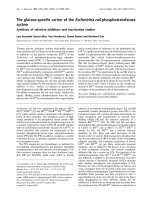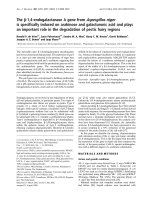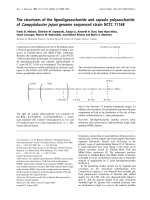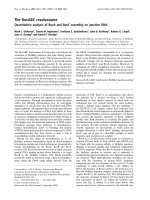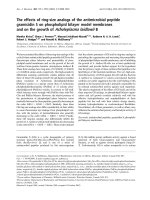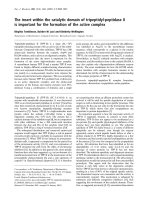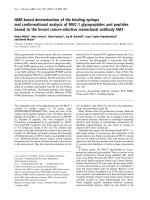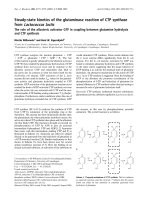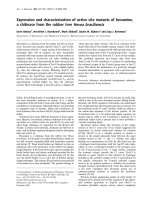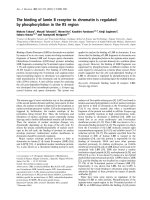Báo cáo y học: "The nosological significance of Folie à Deux: a review of the literature" doc
Bạn đang xem bản rút gọn của tài liệu. Xem và tải ngay bản đầy đủ của tài liệu tại đây (269.73 KB, 8 trang )
BioMed Central
Page 1 of 8
(page number not for citation purposes)
Annals of General Psychiatry
Open Access
Review
The nosological significance of Folie à Deux: a review of the
literature
Danilo Arnone*
1,2
, Anish Patel
3
and Giles Ming-Yee Tan
4
Address:
1
Department of Psychiatry, Warneford Hospital, Oxford, UK,
2
Division of Mental Health, St George's University of London, London, UK,
3
Department of Psychiatry, West Sussex Health and Social Care NHS Trust, Worthing, UK and
4
Department of Psychiatry, University of
Southampton, Southampton, UK
Email: Danilo Arnone* - ; Anish Patel - ; Giles Ming-Yee Tan -
* Corresponding author
Abstract
Background: Folie à Deux is a rare syndrome that has attracted much clinical attention. There is
increasing doubt over the essence of the condition and the validity of the original description, such
that it remains an elusive entity difficult to define.
Method: We conducted a systematic review of the literature of all cases reporting the
phenomenon of Folie à Deux, from the years 1993–2005.
Results: 64 cases were identified of which 42 met the inclusion criteria. The diagnoses in the
primary and secondary were more heterogeneous than current diagnostic criteria suggest. There
exists a high degree of similarity between the primary and secondary in terms of susceptibility to
psychiatric illness, family and past psychiatric history, than previously thought.
Conclusion: Folie à Deux can occur in many situations outside the confines of the current
classification systems and is not as rare as believed, and should alert the clinician to unrecognized
psychiatric problems in the secondary.
Background
Lasègue and Falret [1] first described the phenomena of
the transference of delusional ideas from a 'primary'
affected individual to one or more 'secondaries', in close
association. They coined the term 'Folie à Deux', a rela-
tively rare syndrome that has long since attracted much
clinical attention. Although 'Folie à Deux' is probably the
most widely used term for this type of disorder, many
other terms are used synonymously such as 'double insan-
ity' and 'psychosis of association', leading to considerable
confusion. The early criteria for 'Folie à Deux' outlined by
Lasègue and Farlet assumed some aetiological factors that
significantly shaped subsequent psychiatric thought, with
little supporting evidence or critical examination (Table
1). Since the introduction of validated diagnostic criteria,
very little has changed in the description of the phenom-
ena. Standardised criteria adopt two main terms 'Induced
delusional disorder' (ICD-10) [2], and 'Shared psychotic
disorder' (DSM-IV) [3]. The principal limitation of such
definitions is that they describe phenomena initially for-
mulated in a milieu of societal values and psychodynamic
views of a different era. This was mainly because a priori
assumptions, impregnating the description of this phe-
nomenon and incorporated into operational definitions,
are difficult to test. To complicate matters even further,
there have been attempts to organize the disorder into
subtypes according to the psychopathology encountered
[4]. For example terms like 'Folie Imposee', 'Folie Simul-
Published: 08 August 2006
Annals of General Psychiatry 2006, 5:11 doi:10.1186/1744-859X-5-11
Received: 24 March 2006
Accepted: 08 August 2006
This article is available from: />© 2006 Arnone et al; licensee BioMed Central Ltd.
This is an Open Access article distributed under the terms of the Creative Commons Attribution License ( />),
which permits unrestricted use, distribution, and reproduction in any medium, provided the original work is properly cited.
Annals of General Psychiatry 2006, 5:11 />Page 2 of 8
(page number not for citation purposes)
tanee', 'Folie Communiqué' and 'Folie Indiute' designate
subtypes of the phenomena of 'Folie à Deux' [5]. The lack
of clarity is undoubtedly supported by objective limita-
tions in the aetiological understanding of the syndrome,
its rarity, as well as the limited knowledge of its natural
history and prognosis. In the last century, a plethora of
reports have been published. This has contributed to an
increase in our knowledge of the neuropsychological
mechanisms underlying the phenomena, beyond pure
phenomenological descriptions. This has inevitably led to
questioning not just the actual essence of the condition
but also the validity of the original description in a way
that it now resembles an elusive entity. A review [6], that
adopted operational criteria in the identification of case-
ness, found discrepancies in the original description of
this phenomenon. This work included all the published
literature from 1942 to 1993 and revealed a substantial
shift in the psychosocial aspects of the presentation of
'Folie à Deux'. It also described a high level of psychiatric
morbidity in the secondary accompanied by an extensive
family history for psychiatric illness. In this context expo-
sure to the primary could act as a psychosocial trigger for
a 'transient psychotic phenomenon' in a subject who
would have developed a psychotic episode in any case. In
previously published work, we showed that separation of
the dyad doesn't always result in disappearance of psycho-
pathology [7]. This is highly suggestive of a biological
contribution to the condition. The possibility of psychiat-
ric morbidity in the associate is absent in the description
of the syndrome and doesn't appear in current diagnostic
criteria [7]. Regarding the primary, the authors found a
broader range of psychiatric conditions than what was
originally described [6]. We propose a broader nosologi-
cal entity than the one described by Lasègue. This includes
a wider range of psychiatric conditions in the primary, the
possibility of psychiatric morbidity in the secondary, sus-
ceptibility in the secondary not necessarily limited to gen-
der differences, and the acknowledgement of socio-
cultural changes in the presentation of this condition. We
tested this hypothesis by extending the above-mentioned
review from 1993 to 2005.
Method
This article was intended to update the review conducted
by Silveira and Seeman [6]. The scope of Silveira and See-
man's work was to identify cases of shared psychotic dis-
order, to extrapolate vital information from the literature
and reframe the condition according to a more modern
bio-psychosocial approach. The review also analysed in
detail psychopathology at presentation. Articles were
identified if presented original data, and addressed cases
of induced delusional disorder, shared delusional disor-
der and 'Folie à Deux'. A comprehensive search from a
range of databases including BNI, CancerLit, Cochrane
Library, EMBASE, Medline, Psychoinfo and Pub Med was
conducted from the end of 1993 to 2005. The search was
also complemented by manual search of bibliographic
cross-referencing. There was no restriction on the identifi-
cation of studies in terms of publication status, language
or design type. Key words used to identify the studies
were: INDUCED DELUSIONAL DISORDER, SHARED
DELUSIONAL DISORDER, and FOLIE A DEUX. We
adopted criteria for inclusion similar to Silveira & Seeman
[6]: clear discrimination between primary and secondary
patients, demographic variables (age and gender), diag-
nosis according to diagnostic criteria including co-mor-
bidity, past psychiatric history, family history, social
isolation and other vulnerability factors, the nature of the
relationship between primary and secondary and its dura-
tion, psychopathology, length of exposure to the prima-
ries' psychosis. Management options were also included.
The review excluded cases where more than one second-
ary was involved. We adopted a standardized assessment
sheet (available upon request) to identify suitable articles
and resolved disagreement by consensus.
Results
A total of 64 published cases were identified of which 42
[8-41] met the criteria for inclusion (Figure 1). Findings
(years 1993–2005) were compared with those from Sil-
veira and Seeman's review [6] (years 1942–1993). The
information is divided into the following categories
accompanied with the relevant figures and tables for ease
of explanation.
Demographic characteristics, family and psychiatric
history (Figure 1)
1) Age: In the years 1993–2005 age was reported in 37
(88%) of primary and 33 (79%) of secondary cases. Mean
age was 52.7 for primaries (SD = 17.07) and 45.9 (SD =
16.3) for secondaries. This difference was not statistically
significant (p > 0.05). In the years 1942–1993 the mean
age of the primaries was 48.1 years and for the secondaries
42.9 years. This difference was not statistically significant.
2) Gender: In the years 1993–2005 gender was reported in
41 (98%) of primaries (13 men and 28 women) and 42
Table 1: Lasègue-Falret syndrome
A syndrome prevalent among women living more or less confined, marked by:
Coincidental appearance of psychotic symptoms in members of a family while living together
Appearance of psychotic symptoms in two closely associated persons
Transmission of psychotic symptoms from a sick person to one person or several healthy individuals who elaborate on the induced delusions
Annals of General Psychiatry 2006, 5:11 />Page 3 of 8
(page number not for citation purposes)
(100%) of secondaries (14 men and 28 women). The dif-
ference between men and women in the primaries and
secondaries was not statistically significant (p > 0.05). In
the years 1942–1993, gender was identified in all prima-
ries and secondaries (N = 61, 100%). Primaries consisted
of 18 men and 43 women, and secondaries of 23 men and
38 women. Whilst within the group of secondaries gender
differences were not statistically significant (p = 0.05),
authors recorded an excess of women in the primaries
which reached statistical significance (p = 0.005). 3) Fam-
ily History: In the years 1993–2005, family psychiatric his-
tory was reported in only 10 (23.8%) of primaries and 12
(28.6%) of secondaries. The difference between the two
groups did not reach statistical significance (p = 0.359).
Only the family history of secondaries was considered in
the years 1942–1993 and was recorded in 33 (54.1%) of
the subjects. 4) Psychiatric History: Evidence of psychiatric
history preceding the appearance of 'Folie à Deux' was
reported in 10 primaries (23.8%) and 5 secondaries
(11.9%). The difference between primary and secondaries
was not statistically significant (p = 0.196). This informa-
tion was not elicited in the years 1942–1993.
The nature of the relationship (Table 2)
In the years 1993–2005 the type of relationship between
primaries and secondaries was always well described (N =
42, 100%). The majority of the relationships were within
the nuclear family (97.6%). The remainder occurred
within the context of friendships (2.4%) between geneti-
cally unrelated individuals. The largest proportion was
constituted by married or common-law couples (52.4%)
with a similar distribution between husband and wife.
The second largest group (23.8%) was between sisters
(50% twins). Results emerging from 1942–1993 review
also showed an increased susceptibility of the condition
within the family. However, the dyad parent-child con-
tributed more significantly (N = 19, 31.1%). These
authors specified that offspring were secondaries in
73.7% of cases highlighting a possible increased suscepti-
bility in child inductees. Siblings (sisters) and common
law couples then followed (N = 18, 29.5%).
Risk factors, duration of the association, and exposure in
the dyad (Table 3)
Social isolation has often been described as a major risk
factor for the development of 'Folie à Deux'. Social isola-
tion was reported in 64.3% (N = 27) of the cases identi-
Demographic Characteristics, Family and Psychiatric HistoryFigure 1
Demographic Characteristics, Family and Psychiatric History. Difference in age between primary and secondary: (#)
not statistically significant difference; (##): χ
2
= 7.51, df = 26, p > 0.05. Difference in gender in the primaries: (*) χ
2
alpha =
0.005 df = 1 and (§) χ
2
= 4.67, df = 1, p > 0.05. Difference in gender in the secondaries: (**) χ
2
alpha = 0.05 df = 1 and (§§) χ
2
=
4.67, df = 1, p > 0.05. Difference in family history between primaries and secondaries: (¤)χ
2
= 0.84, df = 1, p = 0.359. Difference
in past psychiatric history between primaries and secondaries: (¶) χ
2
= 1.67, df = 1, p = 0.196. NS = Not stated.
Total number of cases identified, N = 139
1942-1993
N = 75
1993-2005
N = 64
No. cases meeting inclusion criteria
N = 61
No. cases meeting inclusion criteria
N = 42
PRIMARY
Mean age 48.1 #
(SD) Range (NS), 9-81
M:F 18:43
*
FHx N (%) NS
Past Psych NS
Hx
SECONDARY
Mean age 42.9
#
(SD) Range (NS), 10-81
M:F 23:38
**
FHx N(%) 33(54.1)
Past Psych NS
Hx
PRIMARY
Mean age
52.7 ##
(SD) (17.1)
M:F 13:28
§
FHx N (%) 10 (23.8) ¤
Past Psych 10 (23.8) ¶
Hx N (%)
SECONDARY
Mean age 45.9
##
(SD) (16.3)
M:F 14:28
§§
FHx N(%) 12 (28.6) ¤
Past Psych 5 (11.9) ¶
Hx N(%)
Annals of General Psychiatry 2006, 5:11 />Page 4 of 8
(page number not for citation purposes)
fied in the years 1993–2005 and 84% (N = 53) in the years
1942–1993. A number of other factors were also reported
in the secondaries in more recent years: passive personal-
ity, cognitive impairment, language difficulties, and life
events.
The duration of the association between primary and sec-
ondary was found to be in the range of several months in
both 1993–2005 (0.5–81.00 months) and 1942–1993
(3–948 months). Only in the years 1993–2005 the length
of the exposure was recorded with a mean of 72.98
months (SD = 86.46) suggestive of a long exchange of
social interaction between primary and secondaries.
Diagnosis, co-morbidity and psychopathology (Table 4)
1) Diagnosis in the Primary: In 1993–2005, the diagnosis
was recorded in all the cases retrieved (N = 42, 100%). The
commonest diagnosis in the primary was delusional dis-
order followed by schizophrenia and affective disorders.
The diagnosis in the years 1942–1993 was recorded in 54
cases (88.5%), but the order of frequency was different
with schizophrenia first followed by mood disorders and
delusional disorders. 2) Diagnosis and Co-morbidity in the
Secondary: In the secondary, 'Folie à Deux' was the primary
diagnosis in 71.4 % of cases (N = 30) in 1993–2005 and
88.5% (N = 54) in 1942–1993. However other diagnosis
were also highly represented. In 1993–2005 schizophre-
nia was recorded 6 times (14.3%), followed by depression
(N = 3, 7.1%), cognitive impairment (N = 1, 2.4%) and
bipolar affective disorder (N = 2, 4.8%). Similarly in the
years 1942–1993 a co-morbid diagnosis in the secondary
was recorded in 89.0% of cases (N = 48) and included
depression, dementia and mental retardation. 3) Psycho-
pathology: In the primary, delusions were commonly
recorded in both 1942–1993 (N = 54, 88.5%) and 1993–
2005 (N = 53, 87%). Persecutory and grandiose delusions
were most commonly encountered. Notably, in the
majority of cases (98–100%), delusions were identical in
the dyads. In 1993–2005 cases only 2% of secondaries
experienced less intense phenomena and one case of
obsessive thoughts was also reported. In terms of halluci-
nations, much more variability was described and, in gen-
eral, secondaries had a less intense experience in a large
number of cases both in 1993–2005 (N = 13, 52.0%) and
1942–1993 (N = 17, 29.3%). Frequency of hallucinations
was higher in 1942–1993 (N = 58, 95.0%) compared to
1993–2005 (N = 25, 59.5%) but the quality was not
always sufficient to allow a detailed description. When
Table 3: Risk factors, duration of the association, and exposure in the dyad
1942–1993 N (%) 1993–2005 N (%)
Dyad Risk Factors 61 (100) 42 (100)
N (%) Social Isolation: 53 (84) Social Isolation 27 (64.3)
Others in the secondaries: NS Others in the secondaries:
Secondary passive 5 (5.9)
Cognitive impairment 3 (3.5)
Language difficulties 1 (1.2)
Life events 1 (1.2)
Duration of the association (Months) 47 (77.0) 32 (52.4)
Mean (SD), Range NS (NS) 3–948 30.7 (19.07), 0.5–81.00
Duration of the exposure (Months) NS 35 (57.4)
N (%) NS 72.98 (86.46), 0.00–336.00
NS: Not stated
Table 2: The nature of the relationship
Nature of the relationship 1942–1993 N = 61(%) 1993–2005 N = 42 (%)
Husband:Wife 10 (16.4) 12 (28.6)
Wife:Husband 8 (13.1) 10 (23.8)
Parent:Child 19 (31.1) 6 (7.1)
(Mother:Daughter = 5)
(Mother:Son = 1)
Child:Parent 0 2 (4.2)
Siblings 18 (29.5), 3 Twins 11 (26.2), 5 Twins (all F) (Sisters = 10, Brothers = 1)
Friends 6 (9.9) 1 (2.4)
Annals of General Psychiatry 2006, 5:11 />Page 5 of 8
(page number not for citation purposes)
described, auditory hallucinations were the commonest,
followed by somatic and visual. In 1993–2005 one of the
secondaries developed hallucinations not shared by the
primary.
Management (Tables 5 and 6)
Information on management was only available in the
years 1993–2005 and extensively involved separation of
the dyad in most cases. This intervention was commonly
used in combination with medication in both primary (N
= 14, 33.3%) and secondary (N = 13, 30.9%). Use of med-
ication was frequently used alone or in combination. In
particular, antipsychotics and antidepressants were widely
used. In combination, mood stabilisers and antipsychot-
ics were the most successful in both primary and second-
ary, followed by antipsychotics and antidepressants in
one primary only. Treatment settings when reported
involved inpatient management in a large number of
cases for both primary (N = 26, 61.9%) and secondary (N
= 22, 52.4%), followed by outpatient interventions,
absence of follow up and premature death.
Discussion
Current diagnostic criteria highlight the importance of the
absence of psychiatric illness in the secondary other than
psychopathology induced by close proximity with the pri-
mary. Data from case studies shows that this presumed
hypothesis is not always applicable. Secondaries show a
high comorbidity rate which ranges between 28.6–89.0%.
This finding questions the validity of the diagnosis and
supports the possibility that the close proximity of pri-
mary and secondary only constitute a temporal trigger for
a psychiatric condition in already susceptible individuals,
who would have developed a psychiatric disorder anyway.
This is also supported by the high rate of psychiatric mor-
bidity in the secondary also in terms of family history and
past psychiatric history. Family psychiatric history was in
fact present in the secondaries in 28.6–54.1% of cases. In
the years 1993–2005, there was no statistically significant
difference between the primary and the secondary in
terms of the family history (p = 0.359). This suggests a
similarity in genetic loading for psychiatric disorders
between the primary and the secondary. Similarly, there
was evidence of a positive psychiatric history preceding
the appearance of the disorder in both the primaries and
the secondaries although the difference was not statisti-
Table 4: Diagnosis, co-morbidity and psychopathology
Diagnosis N (%) Abnormal thoughts Type, N, (%) Abnormal perceptions Type, N, (%)
1942–1993
Total N 54(88.5) 54 (88.5) 58 (95.0)
Primary Schizophrenia 24 (44.4) Delusions: Hallucinations:
Mood disorders 7 (13.0) Persecutory 46 (75.4) Type clearly described 30 (52.6)
Delusional disorders 6 (11.1) Grandiose 8 (13.1) Not sufficient data 18 (47.4)
Secondary Pure Shared delusional disorder 54 (88.5) Delusions: Hallucinations:
Co-morbidity 48 (89.0): No difference in type or quality reported. Same type but less intense quality 17
(29.3)
Dementia Only in the secondary 2 (3%)
Depression No sufficient data 39 (67.0)
Mental retardation
1993–2005
Total N 45 (100) 53 (87) 25 (59.5%)
Primary Delusional disorder 15 (33.3) Delusions: Hallucinations:
Schizophrenia 13 (28.9)
Depression 3 (6.7)
Bipolar affective disorder 3 (6.7)
Induced delusional disorder 3 (6.7)
Mixed affective disorder 1 (2.2)
Psychosis (NOS) 1 (2.2)
Mixed affective disorder 1(2.2)
Mania 1 (2.2)
OCD 1 (2.2)
Cognitive impairment 1 (2.2)
Persecution 30 (35.3)
Grandiose 13 (15.3)
Erotomanic 4 (4.7)
Somatic 3 (3.5)
Infestation 1 (1.2)
Capgras' 1 (1.2)
Others:
Obsessions and compulsions 1 (1.2)
Auditory 11 (45.8)
Somatic 5 (20.8)
Visual 4 (16.6)
Tactile 3 (12.6)
Olfactory 1 (4.2)
Secondary Pure Induced delusional disorder 30 (71.4)
Co-morbidity 12 (28.6):
Schizophrenia 6 (14.3)
Depression 3 (7.1)
Cognitive impairment 1 (2.4)
Bipolar affective disorder 2 (4.8)
Delusions:
No difference in type between primaries
and secondaries. The intensity of the
experiences was also identical in 98% of
cases. In the remaining 2% secondary had
less intense abnormal thoughts.
Hallucinations:
Same type but less intense quality 13
(52.0%)
As primary 11 (44.0)
Only in secondary 1 (4.0)*
(*) Haptic hallucinations.
Annals of General Psychiatry 2006, 5:11 />Page 6 of 8
(page number not for citation purposes)
cally significant (p = 0.196). The information supports a
high degree of similarity between primaries and secondar-
ies in terms of susceptibility to psychiatric illness. The
common belief highlighted by diagnostic criteria that
'separation' as the means of treatment of the secondary is
the only and sufficient intervention required is also not
supported in this review. Secondaries were extensively
treated with medication to similar levels of the primaries,
often in conjunction with separation and other interven-
tions (e.g. psychotherapy), revealing that separation is not
always the treatment of choice for the secondaries. Among
predisposing factors linked to the development of the dis-
order, social isolation was reported very frequently
between 64.3% and 84%. However, a number of other
factors were also reported like passive personality, cogni-
tive impairment, language difficulties, and life events.
This is partly in keeping with current diagnostic criteria
but also expands on the possible existence of other factors
which constitute a disadvantage for the secondary which
are not necessarily related to the primary. Some of these
factors can be considered predisposing factors for mental
illness in their own right. The diagnosis in the primaries
was found to be more heterogeneous than current diag-
nostic criteria suggest. Although schizophrenia is indeed
very common, delusional disorder, and affective disorders
were also commonly seen, implying that a wider inclu-
sion criteria could be adopted. In terms of the content of
delusions, persecutory and grandiose were very common
but there was a plethora of other different types. Further-
more, hallucinations, which are currently not included in
the diagnostic criteria occur frequently and therefore
could be included in future versions of a diagnostic classi-
fication system.
Limitations
Limitations in this study include the variability of diag-
nostic criteria (e.g. ICD 10 and DSM IV) used in the iden-
tification of caseness which although standardised are not
entirely identical. If we had adopted non-standardised cri-
teria for the identification of the disorder, it would have
led to over-inclusion of numerous reports, thus limiting
the validity of the review. Finally, although the inclusion-
exclusion criteria adopted by this article were tailored on
Silveira and Seeman's review [6], there may be some fur-
ther methodological differences which allowed only com-
parison but not combination of data. For instance, we
adopted a more inclusive searching strategy to minimize
publication bias and we dealt with disagreement by con-
sensus. With all the limitations, this article offers the larg-
est and most up to date review of cases of 'Folie à Deux'
ever published and supports a possible variability in the
condition and emphasises the necessity of further work in
the future.
Conclusion
We set out to propose a broader nosological entity than
that originally described by Lasègue in 1877 [1] on the
phenomenon of 'Folie à Deux'. We carried out a review of
all cases reporting the phenomenon of 'Folie à Deux' from
the years 1993–2005, which followed on from an earlier
review by Silveira and Seeman [6]. Our findings on the
whole were in keeping with those of Silveira and See-
man's, and suggest that the phenomenon of 'Folie à Deux'
first described in 1877 and the criteria necessary to make
its diagnosis within current classification systems to be
insufficient. The data shows that the primary need not
only have schizophrenia to induce shared psychotic
Table 6: Treatment settings
Primary N (%) Secondary N (%)
Inpatient 26 (61.9) 22 (52.4)
Outpatient 4 (9.5) 7 (16.6)
No Follow up 4 (9.5) 4 (9.5)
Death 1 (2.4) 1 (2.4)
Table 5: Treatment options
Primary N (%) Secondary N (%)
Separation only 5 (11.9) 8 (19.0%)
Separation and medication 14 (33.3) 13 (30.9)
Medication alone 30 (71.4) 26 (61.9)
Antipsychotics 15 (35.7) Antipsychotics 9 (21.4)
Antidepressants 1 (2.4) Antidepressants 2 (4.8)
Non specified 14 (33.3) Non specified 15 (35.7)
Medication in combination 5 (11.9) 2 (4.8)
Mood stabilisers/antipsychotics 4 (9.5) Mood stabilisers/antipsychotics 2 (4.8)
Antidepressants/antipsychotics 1 (2.4)
Psychotherapy 2 (4.8) 6 (14.3)
ECT 1 (2.4) 0 (0)
Others 0 (0) 1 (2.4)*
(*) Cardio conversion
Annals of General Psychiatry 2006, 5:11 />Page 7 of 8
(page number not for citation purposes)
symptoms in the secondary, but that a variety of other
mental illnesses could also be responsible. The shared
psychotic symptoms themselves need not only be delu-
sions but also be hallucinations. Secondaries, tradition-
ally described to have a submissive role in the dyad but
otherwise mentally sound, could actually be extremely
vulnerable to developing or having a significant mental
illness themselves. The treatment that is often advocated
ie. separation, has also been shown to be inadequate or
insufficient in a large number of cases. We hope these
findings make clinicians aware that the phenomenon that
is essentially the transfer of psychotic symptoms from one
(primary) individual to another (secondary) can occur in
many situations outside of the confines of the current
diagnostic classification systems and therefore is perhaps
not as rare as is believed; and that the occurrence of shared
psychotic symptoms should alert the clinician to further
investigate the presence or monitor the development of
any mental illness in the secondary as this may go unrec-
ognised.
Competing interests
DA has received bursaries from Janssen-Cilag Ltd.
Clinical implications
• Folie à Deux can occur in many situations outside the
confines of current diagnostic classification systems, and
is perhaps not as rare as is believed.
• The occurrence of the phenomenon of Folie à Deux
should alert the clinician to investigate the presence or
monitor the development of psychiatric illness in the sec-
ondary.
• Separation is often the treatment option most advo-
cated, but it may be inadequate or insufficient.
Limitations
• There was variability of the diagnostic criteria (i.e. ICD-
10 and DSM-IV) used in the identification of cases which
although standardised are not entirely identical.
• Due to methodological differences in the collection of
data we were unable to combine our results with an earlier
review and could only draw comparisons to it.
• The review was based on data that was not critically
appraised as it was collected
References
1. Lasègue C, Falret J: La folie à deux. Ann Med Psychol 1877,
18:321-355.
2. World Health Organization: The ICD-10 Classification of Mental
and Behavioural Disorders. Geneva; 1992.
3. American Psychiatric Association: Diagnostic and Statistical
Manual of Mental Disorders. 4th edition. Washington DC: Amer-
ican Psychiatric Association; 1994.
4. Wehmeier PM, Barth N, Remschmidt H: Induced Delusional Dis-
order. A review of the concept and an unusual case of folie à familie. Psy-
chopathology 2003, 36:37-45.
5. Sims A: Symptoms in the Mind. In An introduction to descriptive psy-
chopathology 2nd edition. WB Saunders; 1995.
6. Silveira JM, Seeman MV: Shared Psychotic disorder: A Critical
Review of the Literature. Can J Psychiatry 1995, 40:389-395.
7. Patel AS, Arnone D, Ryan W: Folie à deux in bipolar affective dis-
order: a case report. Bipolar Disorders 2004, 6:1-4.
8. Arenz D, Hoflich G: Psychopathological concepts of induced
insanity exemplified by folie à deux. Fortschr Neurol Psychiatr
1996, 64(1):13-19.
9. Arenz D, Stippel A: Communicated insanity, folie à deux and
shared psychotic disorder. Different concepts and a case
from Mallorca. Fortschr Neurol Psychiatr 1999, 67(6):249-255.
10. Burke D, Dolan D, Schwartz R: Folie à deux: three cases in the
elderly. Int Psychogeriatr 1997, 9(2):207-212.
11. Caduff F, Hubschmid T: Folie à deux. Review of the literature
and an unusual case. Nervenarzt 1995, 66(1):73-77.
12. Cervini P, Newman D, Dorian P, et al.: Folie à deux: an old diag-
nosis with a new technology. Can J Cardiol 2003,
19(13):1539-1540.
13. Christodoulou GN, Margariti MM, Malliaras DE, et al.: Shared delu-
sions of doubles. J Neurol Neurosurg Psychiatry
1995, 58(4):499-501.
14. Colombo G, Caimi M, Dona GP, et al.: Shared Ekbom's syn-
drome. A case Study. Eur Psychiatry 2004, 19(2):115-116.
15. Cypriano LV, Rocha FDM, Souza GFJ: Folie à deux – A clinical
case report. Psiquiatria Biologica 2000, 8(3):89-94.
16. Dantendorfer K, Maierhofer D, Musalek M: Induced hallucinatory
psychosis (folie à deux hallucinatoire): pathogenesis and
nosological position. Psychopathology 1997, 30(6):309-315.
17. Ferro FM, Pacilli AM: La Folie à Deux: Il caso di una simbiosi
madre-figlio. Imago 2003, 10(1):57-68.
18. Florez G, Gomez-Reino I: Simultaneous madness in twin sisters.
Eur Psychiatry 2001, 16(8):501-502.
19. Gandor C: Folie à deux in depressive disorders. Psychiatr Prax
1997, 24(3):152-153.
20. Harmon C, Rames L: Folie à deux in identical twins. Hosp Com-
munity Psychiatry 1994, 45(12):1238-1239.
21. Lai Tony TS, Chan WC, Lai David MC, et al.: Folie à deux in the
aged: a case report. Clinical Gerontologist 2001, 22(3–4):113-117.
22. Latha KS: Folie à deux: a case report of shared delusional dis-
order. NIMHANS Journal 2000, 18(1–2):63-66.
23. Lawal RA, Orija OB, Malomo IO, et al.: Folie-à-deux: report of two
incidents. East Afr Med J 1997, 74(1):56-58.
24. Lerner V, Greenberg D, Bergman J: Daughter-mother folie a
deux: immigration as a trigger for role reversal and the
development of folie à deux. Isr J Psychiatry Relat Sci 1996,
33(4):260-264.
25. Malik MA, Condon S: Induced psychosis (folie à deux) associ-
ated with multiple sclerosis.
Irish Journal of psychological Medicine
2000, 17(2):73-74.
26. Metzger W, Steinert T, Schmidt-Michael PO, Weissenau M: Zeitlich
durch okkulte Praktichen induzierte paranoid-halluzinator-
ische Psychose bei zwei Schwestern. Psychiatrische Praxis 1996,
23(4):199-200.
27. Neagoe AD: Abducted by aliens: a case study. Psychiatry 2000,
63(2):202-207.
28. Ouedraogo A, Kere M, Samuel-Lajeunesse B: A case of 'folie à
deux' in Ouagadougou (Burkina Faso). Evolution Psychiatrique
1997, 62(4):703-710.
29. Petrikis P, Andreou C, Garyfallos G, et al.: Incubus syndrome and
folie à deux: a case report. Eur Psychiatry 2003, 18(6):322.
30. Porter TL, Levine J, Dinneen M: Shifts of dependency in the res-
olution of folie à deux. Br J Psychiatry 1993, 162:704-706.
31. Cordeiro Q Jr, Pereira-Corbett CE: Delirio de infestação
parásitária e folie à deux. Arq Neuropsiquiatr 2003, 61(3-
B):872-875.
32. Raulin C, Rauh J, Togel B: "Folie à deux" in the age of lasers. Hau-
tarz 2001, 52(12):1094-1097.
33. Reif A, Pfuhlmann B: Folie à deux versus genetically driven delu-
sional disorder: case reports and nosological considerations.
Compr Psychiatry 2004, 45(2):155-160.
34. Dympna-Ryan CM, Khan SA, et al.: Reversal of roles in folie à
deux associated with manic depressive illness. Irish Journal of
Psychological medicine 1992, 9(1):55-57.
Publish with BioMed Central and every
scientist can read your work free of charge
"BioMed Central will be the most significant development for
disseminating the results of biomedical research in our lifetime."
Sir Paul Nurse, Cancer Research UK
Your research papers will be:
available free of charge to the entire biomedical community
peer reviewed and published immediately upon acceptance
cited in PubMed and archived on PubMed Central
yours — you keep the copyright
Submit your manuscript here:
/>BioMedcentral
Annals of General Psychiatry 2006, 5:11 />Page 8 of 8
(page number not for citation purposes)
35. Sanjurjo-Hartman T, Weitzner MA, Santana C, et al.: Cancer and
folie à deux: case report, treatment, and implications. Cancer
Pract 2001, 9(6):290-294.
36. Schatzle M: A remarkable case of folie à deux. Nervenartz 2002,
73(11):1100-1104.
37. Shimizu M: Folie à deux in schizophrenia – "psychogenesis"
revisited. Seishin Shinkeigaku Zasshi 2004, 106(5):546-563.
38. Shiwach RS, Sobin PB: Monozygotic twins, folie à deux and her-
itability: a case report and critical review. Med Hypotheses
1998, 50(5):369-374.
39. Sugahara H, Otani Y, Sakamoto M: Delusional parasitosis accom-
panied by word deafness due to cerebral infarction: folie à
deux. Psychosomatics 2000, 41(5):447-448.
40. Torch EM: Shared obsessive-compulsive disorder in a married
couple: a new variant of folie à deux? J Clin Psychiatry 1996,
57(10):489.
41. Wolff G, McKenzie K: Capgras, Fregoli and Cotard's syn-
dromes and Koro in folie à deux. Br J Psychiatry 1994,
165(6):842.
